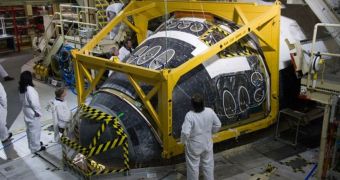Officials at the US National Aeronautics and Space Administration (NASA) have recently announced that they have delayed the official launch date for space shuttle Discovery. Under the new and revised launch manifest, the shuttle would not take off any earlier than April 5. The reason for this is that unusually cold weather has prevented experts working on Discovery from moving it into the Vehicle Assembly Building (VAB), for final processing and mating with its external fuel tank.
The spacecraft is currently in the Orbiter Processing Facility (OPF), at the Kennedy Space Center (KSC), in Cape Canaveral, Florida. In this building, engineers conduct maintenance and upgrade work. After a shuttle is given the “go,” it is moved to the VAB, where it is hoisted up, and then mounted atop the Crawler Transporter Vehicle, alongside its external fuel tanks. Discovery was supposed to be moved to the VAB soon, but the cold weather forced engineers to call off the move, and await clearer conditions. The announcement came on Tuesday, Space reports.
NASA flight planners were hoping to launch the spacecraft on March 18, on a resupply mission to the International Space Station (ISS). The STS-131 mission will carry a new Multi-Purpose Logistics Module (MPLM), which is a large space container used for delivering supplies to and from the ISS. When not in use, these modules are stored on various nodes on the outpost. Thus far, only three MPLMs have been built – Leonardo, Raffaello and Donatello. In addition, a number of scientific experiments and other payloads will also be delivered, in a flight that is believed to carry the most varied array of cargo since the STS-107 mission.
According to engineers, if Discovery is to be moved, there need to be about four hours of constant, acceptable temperatures, with little to no fluctuations. They explain that cool temperatures can make some seals leak, while others may become brittle. Spokespersons for the agency said that there was no way to keep Discovery warm as it was being transported from the OPF to the VAB, and that the crew at the spaceport was entirely dependent on exterior weather. They added that Discovery's new flight would be the second mission of the last five scheduled by NASA before the fleet was retired, in September.

 14 DAY TRIAL //
14 DAY TRIAL //